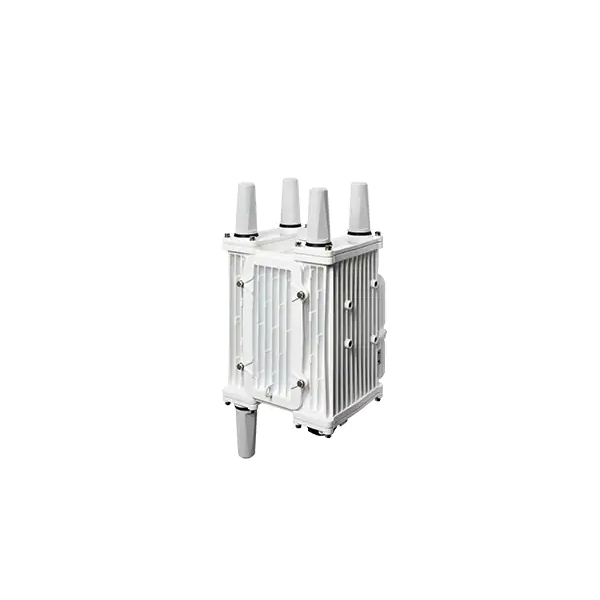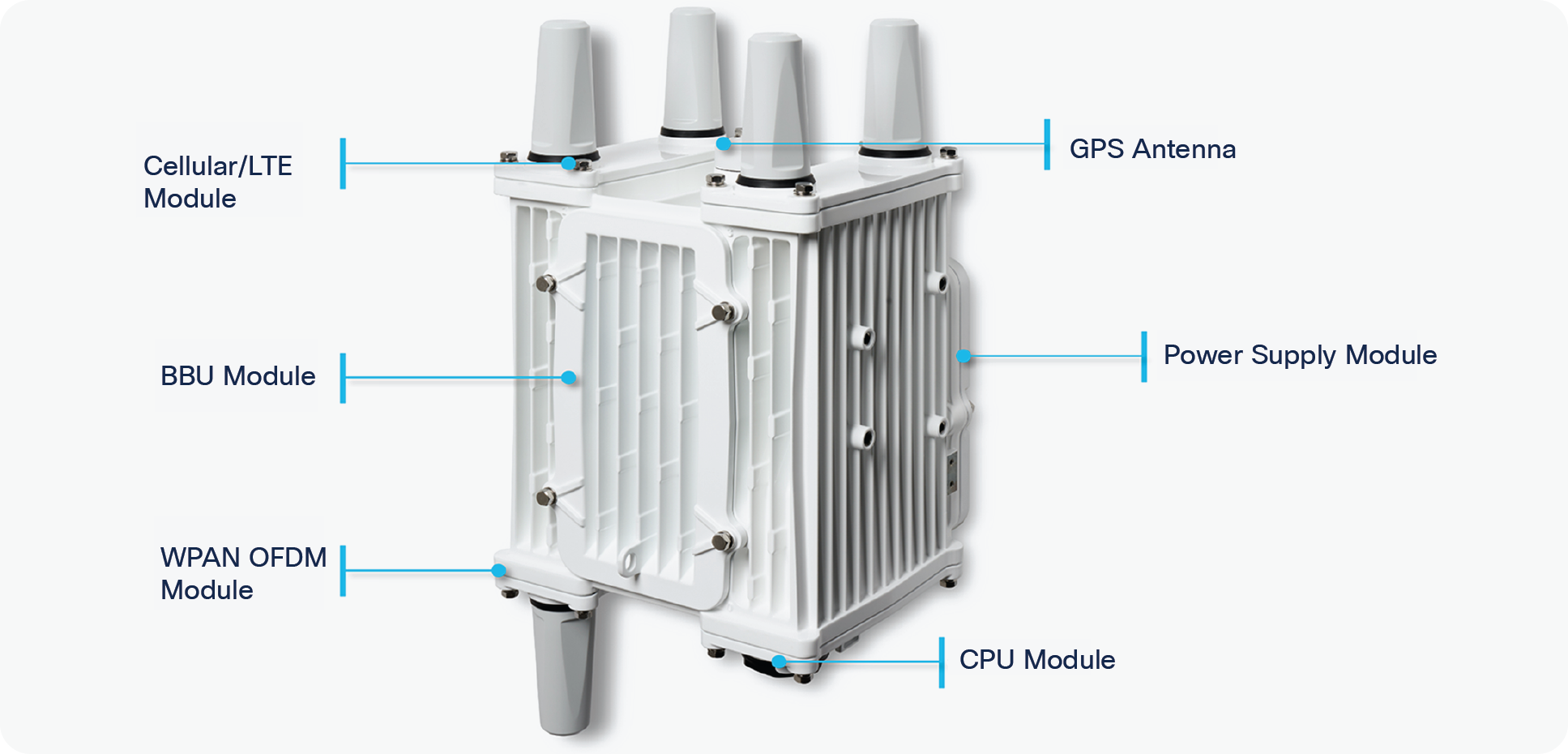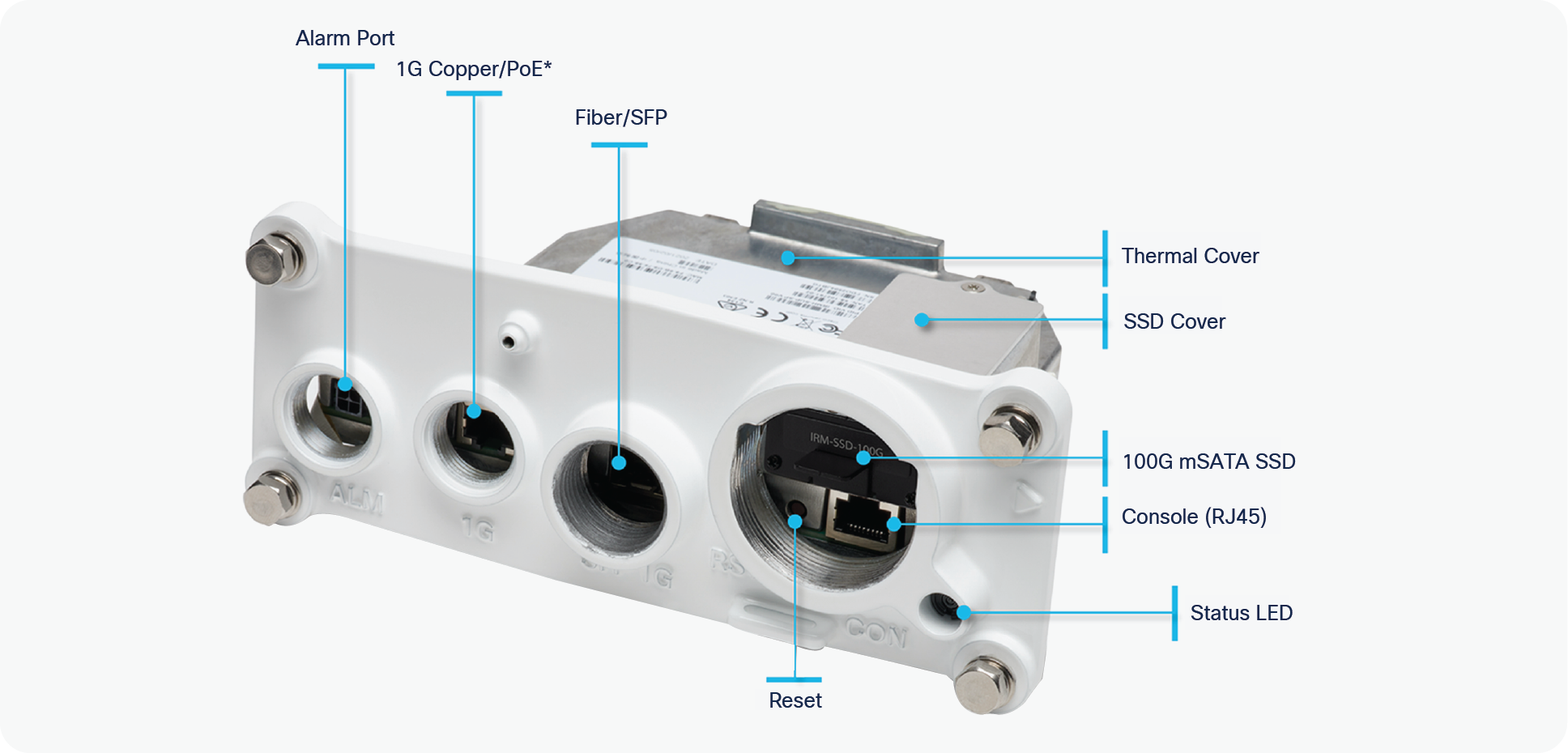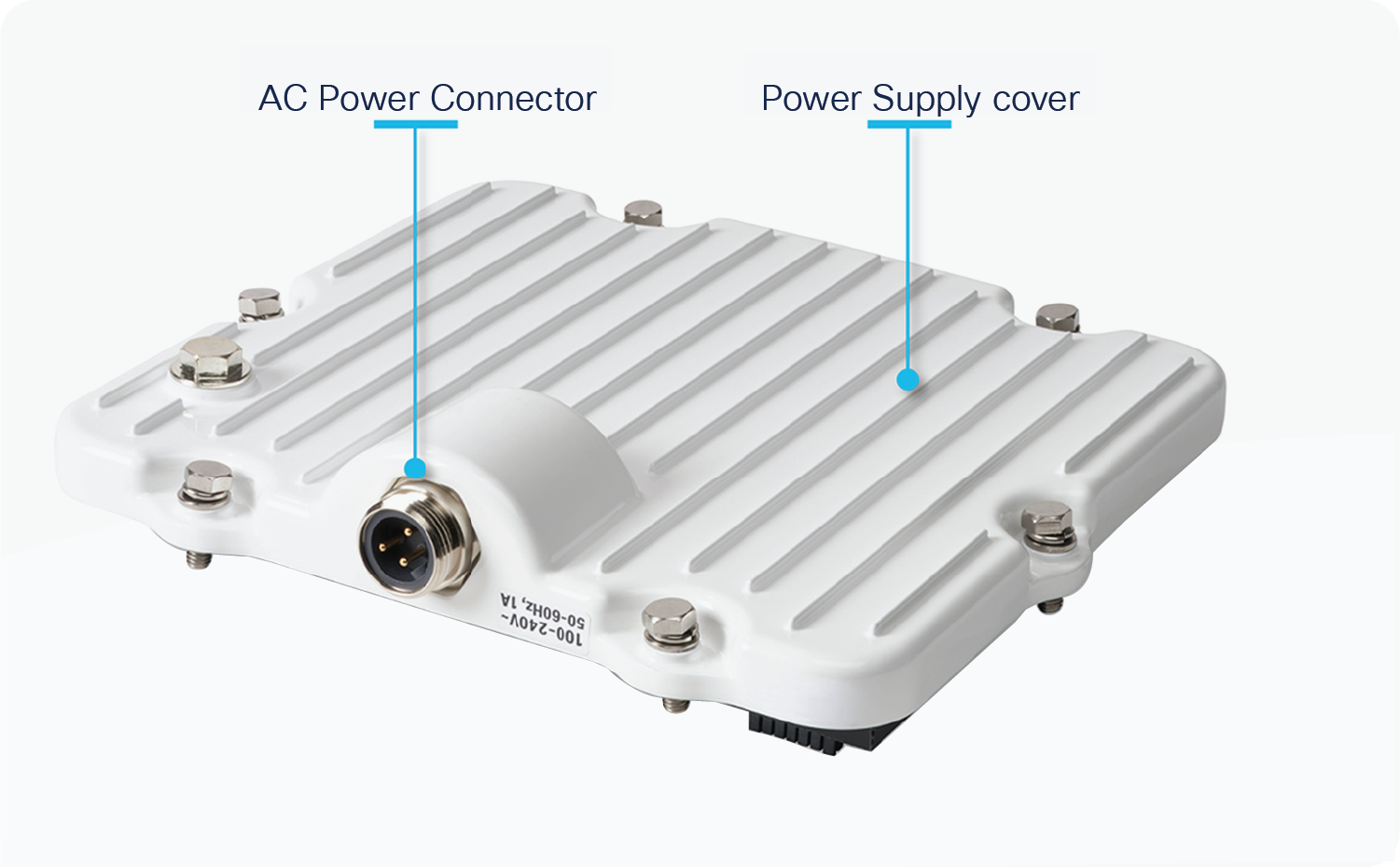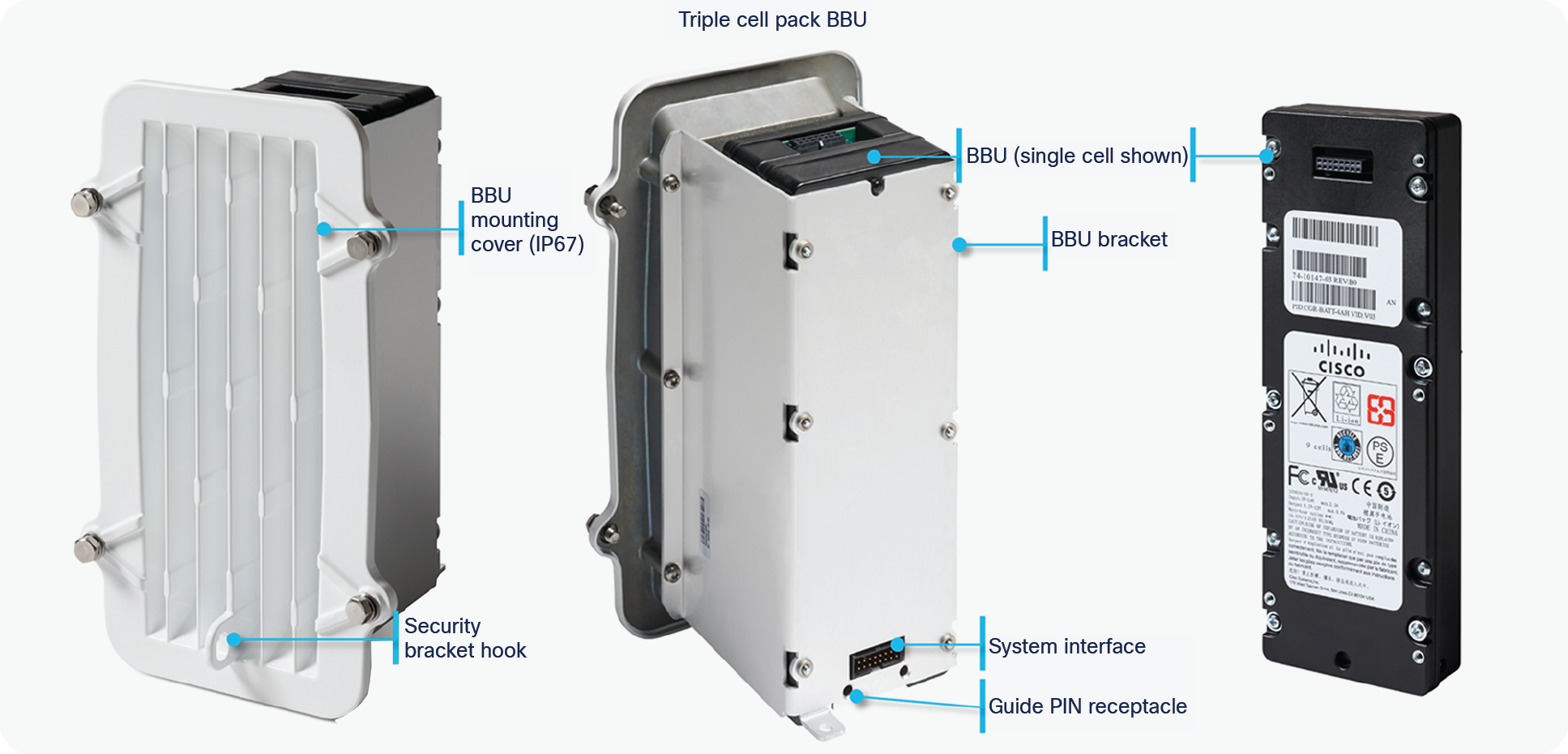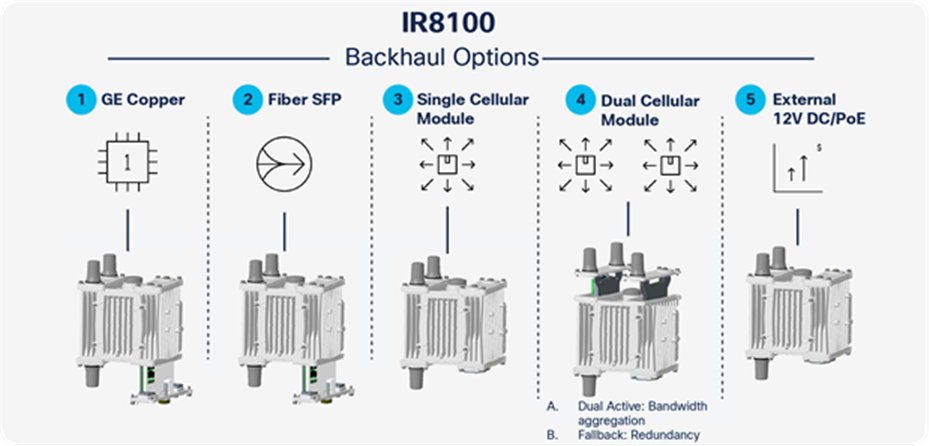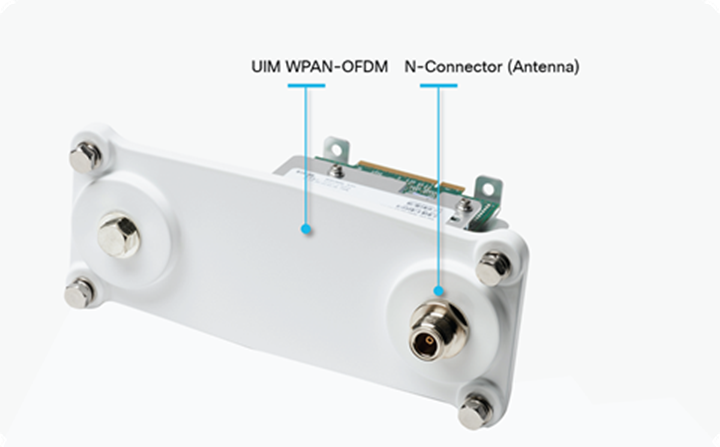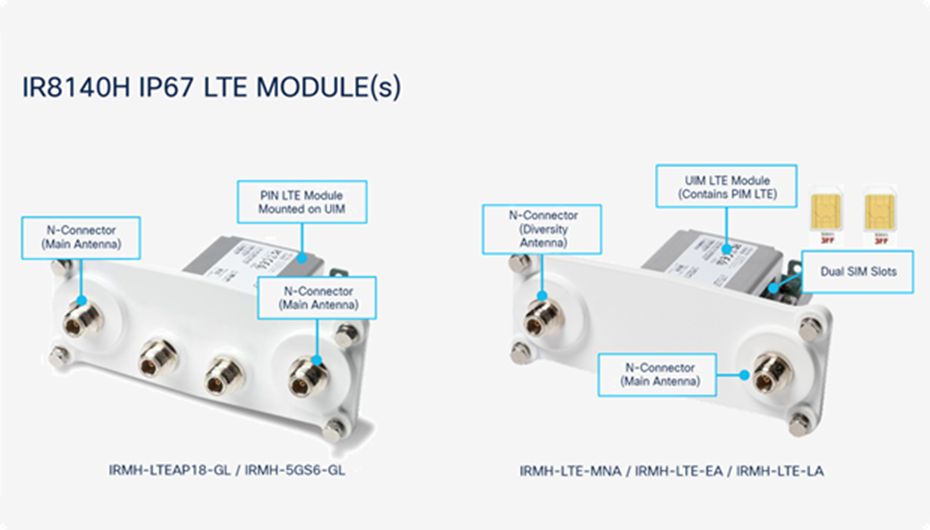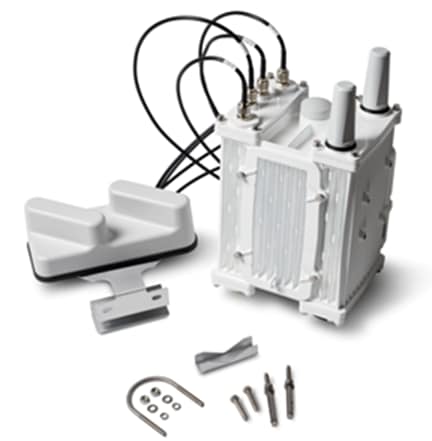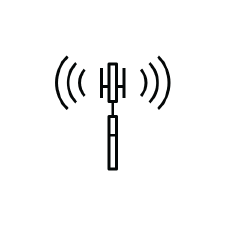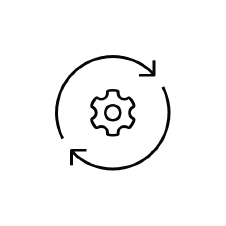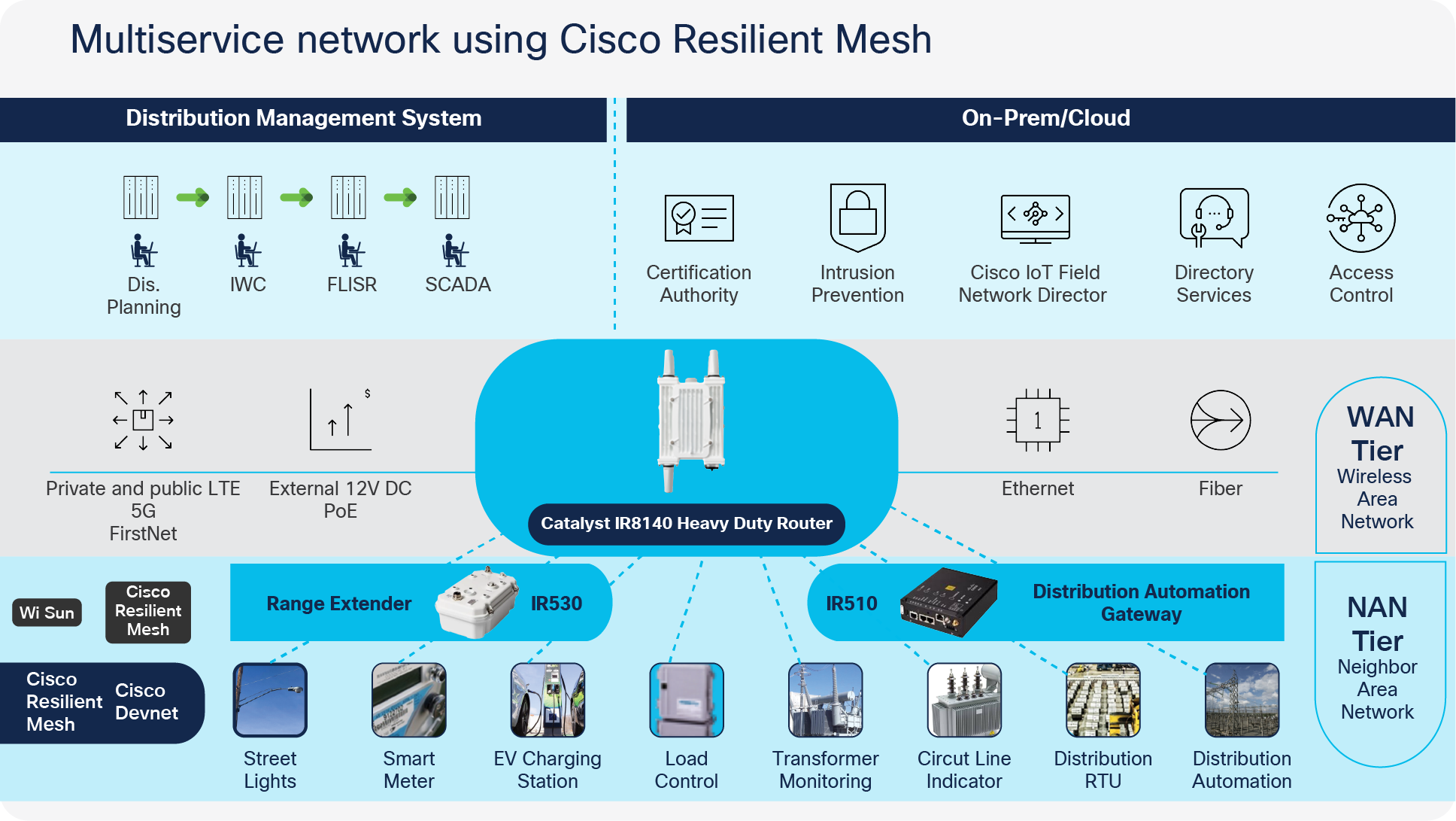IR8140H-K9 Heavy Duty Series Router (LTE, LTE-Advanced, LTE Advanced Pro, 5G Sub-6GHz1, RJ45/SFP Ethernet)
€1,964.32
Product highlights |
Overview of the Catalyst IR8100 Heavy Duty Series
Catalyst IR8140H platform front view
The IR8100 router offers a modular platform designed to meet the evolving needs of industrial settings.
The following components are essential to the operation of the IR8100 router and must be ordered with every chassis:
CPU/supervisor module (PoE port available only on the IR8140H-P-K9)
60W AC power supply module
Battery Backup Unit (BBU) module
Backhaul options
The following optional modules can be purchased with the IR8140H.
Wireless Personal Area Network (WPAN) Wi-SUN module
Cellular modules
Cellular module (IRMH-LTEAP18-GL) with the 4-in-1 multi-element antenna (ANT-4-5G4-O)
Key features |
|
Modularity and investment protection. A single form factor with multiple WAN (LTE, LTE-Advanced, LTE Advanced Pro, 5G Sub-6GHz1, RJ45/SFP Ethernet) and storage options enables flexibility to add or upgrade modules as technologies evolve. The platform offers CPU modularity and power upgradability, which are key to the longevity of the platform. |
|
|
Dual active 5G/LTE-capable modules. With two 5G1 or LTE modules (LTE and LTE-Advanced/Advanced Pro with carrier aggregation), the IR8100 enables concurrent connectivity to two public and/or private cellular networks for WAN redundancy, enhanced data throughputs, load balancing, and differentiated services, making it a highly reliable and high-performance platform. |
|
|
Multiple packet data networks. Connect to different Access Point Names (APNs) for traffic segregation over a public or private cellular link. For example, public internet traffic can be kept separate from mission-critical traffic emerging from the sensors and devices connected to the router. |
|
|
5G1 and 4G LTE multiple-bearer Quality of Service (QoS). Differentiated treatment of traffic with multiple simultaneous bearers per 3GPP standards for an enhanced user experience. Multiple-bearer QoS depends on the cellular carrier’s ability to support the service in their network. |
|
|
Software-Defined WAN (SD-WAN) capable. For high WAN availability and simplicity for large-scale distributed networks, Cisco IOS® XE provides both autonomous and controller (SD-WAN) mode support. |
|
|
802.15.4 902–928MHz Wi-SUN mesh capable. With a Wi-SUN/RF Mesh-enabled WPAN module, the platform enables Cisco Resilient Mesh endpoints and Wi-SUN-enabled endpoints to connect. |
|
|
PoE capability. The IR8140H-P-K9 allows up to 15W of Power over Ethernet (PoE) to power PoE-capable devices. Additional 12V DC output is available for powering external devices. |
|
|
Industrial security. With Cisco Trust Anchor Technology helping ensure the authenticity of the hardware and software, hardware-accelerated Next-Generation Encryption and Quantum Computer Resistant algorithms, firewall and VPN services, and alerts and notifications enabling physical and cyber security, the IR8100 offers multilayer security for mission-critical deployments. |
|
|
Edge computing. Respond to events more quickly and conserve network bandwidth by analyzing the most time-sensitive data at the network edge, close to where it is generated. A highly secure, extensible environment for hosting applications helps ensure authenticity of applications. An optional field-replaceable SSD allows for storage of application data for recording and analysis. |
|
|
Smart grid compliant. Designed for installation in harsh secondary substation environments. Complies with IEEE 1613 and IEC 61850-3 for distribution automation. |
|
|
GPS/GNSS. Location-based services for tracking assets and protecting them from theft and intrusion. |
|
|
Ease of management. On-premises and cloud-based network management solutions cater to businesses across multiple industries. Tools such as Cisco DNA Center, Cisco IoT Operations Dashboard, Cisco IoT Field Network Director, and Cisco Network Plug and Play (PnP)2 simplify deployment and offer breadth in the form of cross-network management and depth in multilayer visibility. |
|
|
Network segmentation. Multi-VRF and VPN enable businesses to configure and maintain more than one instance of a routing and forwarding table within the same customer edge device, enabling dynamic changes in the network with a minimal maintenance window. Service providers can enable this feature to support two or more VPNs with IP addresses that overlap across the VPNs. |
Business benefits and use case examples |
Multiservice network using Cisco Resilient Mesh
Security principles |
|
Sec Security principle |
CIS. Features and capabilities |
|
Access control |
● Mutual authentication and authorization of all nodes connected to the network
● IEEE 802.1X-based authentication, Role-Based Access Control (RBAC)
● Certificate-based identity, strong username, and passwords
|
|
Data integrity, confidentiality, and privacy |
● Link-layer encryption in the Wi-SUN mesh (AES-128)
● Network-layer encryption in the WAN (IPsec for VPN, I.e. FlexVPN, DMVPN)
● Scalable key management, generation, exchange, and revocation of encryption keys
|
|
Threat detection and mitigation |
● Network segmentation of users, devices, and applications in Wi-SUN mesh and WAN
● Access lists to filter traffic between users and devices
● High-performance firewall in the control center to protect critical assets
● Supports Cisco Cyber Vision, providing visibility into industrial assets connected to the router (post-FCS)
|
|
Device and platform integrity |
● Tamper-resistant mechanical design; security alerts generated if compromised
● Hardware chip to store the router’s X.509 certificate and other security credentials
● Tamper-proof secure storage of router configuration and data
|
Features |
|
IoT enablement |
|
|
Modular, ruggedized form factor |
Designed for installation in outdoor rugged environments. Upgradable supervisor module helps ensure that the router is future-ready. Three modular slots allow for a variety of radio technologies to support a choice of backhaul and field device connectivity. Modular power supply provides up to 60W of AC power. |
|
Edge compute |
Built-in edge compute environment with up to 100 GB of optional external storage available to edge applications hosted on the router. |
|
Battery backup unit |
The router supports up to three 4 Ah battery packs to handle extended outages and provide backup power for extended periods. |
|
Optional PoE or 12V DC out |
PoE is capable of providing up to 15W of power to third-party and external devices attached to the PoE port. Alternatively, a 12V DC power is available to connect an external device or interface. |
|
High performance to run concurrent services |
The multicore processor architecture allows businesses to take advantage of network-supported speeds while also hosting edge compute applications. |
|
Multiple WAN and LAN connections |
|
|
WAN diversity |
● Multiple WAN links for high reliability:
|
|
Dual active 5G/LTE interfaces |
Concurrent connectivity to two cellular networks for high reliability, load balancing, and differentiated services. |
|
Transparent roaming between wireless networks |
|
|
Dual SIMs over cellular |
Provides active and backup connectivity for high reliability over cellular networks. |
|
Cisco IOS XE mobile IP |
● Transparent roaming for mobile networks, enabling mission-critical applications to stay connected, even when moving between networks.
● IP addresses assigned to the home network are maintained in private and public networks.
● Supports Proxy Mobile IP (PMIPv6) and Network Mobility (NEMO).
|
|
Cellular fallback |
Multiple technologies (5G,1 4G LTE, 3G) are available to support connectivity to the best one available. 2G fallback is not supported in North America. |
|
Software |
|
|
Cisco IOS XE Software |
Designed to enable businesses to deploy services more quickly with lower TCO: ● Rich functionality. Brings the full range of enterprise-class routing features to IoT applications to help ensure interoperability with IT infrastructure and provide advanced security, segmentation, and reliability features.
● Autonomous and controller mode (SD-WAN) in a unified software image.
● Openness and programmability: Standards-based programmable interfaces enable process, telemetry, and workflow automation. NETCONF, RESTCONF, IETF YANG, Python scripting, and custom libraries enable automation of event-based workflows.
● Secure: Multilevel, end-to-end security and trust are built in. The built-in Cisco Next-Generation Encryption and Quantum Computing Resistant algorithms are expected to meet security and scalability requirements for the next two decades.
● Modular: Enables patching of software bug fixes and graceful insertion and removal of software modules for ease of maintenance.
● Common software stack: Reduces business and network complexity while managing an array of Cisco devices.
|
Network management solutions |
|
Operational phase |
Application |
Description |
|
Stage and configure a few routers |
Cisco WebUI |
A GUI-based device-management tool that simplifies provisioning of devices for a small-scale deployment through easy-to-use wizards. |
|
Deploy, manage, monitor, and maintain IoT gateways and assets at scale |
Cisco IoT Field Network Director for hosting on premises |
● Rapid scaling: Zero-touch deployment and secure enrollment for tens of thousands of gateways.
● Enhanced security: Role-based access and user audit trail and secure communications for data transport across networks, VPN tunnels, geo-fencing, alerts, and notifications for data and physical security.
● Increased reliability: Reliable communications over cellular or Ethernet networks, lifecycle management, and 24/7 real-time monitoring and alerts.
|
|
Extend your enterprise network to configure, monitor, and manage industrial assets |
Cisco DNA Cisco DNA with SD-WAN |
● Cisco DNA offers a network infrastructure that not only is fully programmable and open to third–party innovation, but also can fully and seamlessly integrate the cloud as an infrastructure component.
● Simplifies and automates processes and workflow by bringing the notion of user-aware and application–aware policies into the foreground of network operations.
● With Cisco DNA, the network can provide continuous feedback to simplify and optimize network operations.
● Enables automation of network configuration. Delivers software-defined networking to extend the enterprise network to harsh industrial and outdoor environments.
● Single management dashboard for configuration and management of WAN.
● Cisco SD-WAN automates application flexibility over multiple connections, such as the internet, MPLS, and wireless 4G LTE/5G. 1
|
Embedded management capabilities |
|
Cisco IOS Embedded Event Manager (EEM) |
A distributed and customized approach to event detection and recovery. Provides the ability to monitor events and take corrective or any other desired action when the monitored events, such as a high or low threshold, occur. |
|
|
Cisco IOS XE IP Service-Level Agreements (IP SLA) |
Helps assure the performance of new, business-critical IP applications as well as IP services by actively monitoring and reliably reporting traffic statistics such as jitter, response time, packet loss, and connectivity. |
|
|
Simple Network Management Protocol (SNMP), Syslog, NetFlow |
Open-standards-based network monitoring and accounting tools, such as SNMP for 3G, 4G provide a common management platform for many different devices. |
|
|
LTE network management and diagnostics |
A dedicated diagnostic port on a cellular module enables logging of data during debugging sessions that can be analyzed by industry-standard tools such as Qualcomm CDMA Air Interface Tester (CAIT) and Spirent Universal Diagnostic Monitor (UDM). |
Specifications |
|
Chassis details |
IR8140H-K9 IR8140H-P-K9 (PoE enabled) |
|
Ingress protection rating |
IP67 |
|
Modular slots |
● Supervisor module (mandatory)
● Power supply module (mandatory)
● Battery mounting kit (mandatory)
◦ Houses up to 3 Battery Backup Units (BBUs) with smart charging/monitoring ◦ Each BBU is 4 Ah, providing a total of 12Ah with 3 BBU units ● 4 Universal Interface Module (UIM) slots, including CPU supervisor module.
|
|
GPS/GNSS |
Yes |
|
Physical characteristics |
|
|
Physical dimensions (H x W x D) Without antennas With multipurpose antennas |
34.04 x 23.87 x 25.15 cm (13.4 x 9.4 x 9.9 in) 50.8 x 23.87 x 25.15 cm (20.4 x 9.4 x 9.9 in)
|
|
Maximum chassis weight: 4 UIM modules, AC power supply, 3 BBUs |
30 lb (13.4 kg) |
|
Mounting options |
Wall, pole mount |
|
Supervisor module |
|
|
Console |
RJ-45 |
|
WAN interfaces |
● 10/100/1000 Gigabit Ethernet port (copper). PoE enabled on IR8140H-P-K9
● 10/100/1000 Gigabit Ethernet SFP.
|
|
Default and maximum DRAM |
8 GB |
|
Default and maximum flash memory |
8 GB (usable) |
|
Backup memory |
4 GB (usable) |
|
Edge compute module |
100-GB SSD |
|
Digital alarms (I/O) |
2 |
|
LED |
System OK |
|
Power specifications |
|
|
Power supply specifications |
60W AC power supply (100W AC power option available) Operating range: 100 to 240V AC |
|
External power options |
Option 1: 12V DC out for powering external third-party devices Option 2: 15W of PoE available to power third-party devices |
|
Typical power consumption or dissipation* |
18.2W |
|
Maximum power consumption or dissipation* (with and without charging) |
27W 39.5W (with charging all 3 BBUs) |
|
Power consumption (CPU chassis) |
Idle: 10W Typical: 15W Maximum: 16W |
|
Power consumption (cellular/WPAN) |
Idle: 2W Typical: 3W Maximum: 5W |
|
UIMs |
|
|
IEEE 802.15.4g WPAN (OFDM/FSK) |
Supports up to two 900 MHz WPAN modules |
|
Cellular modules (LTE Category 4/6/18, 5G sub-6 GHz) |
Supports up to two cellular modules in active/active or active/standby mode |
|
Supervisor module |
Supports one supervisor module |
Environmental characteristics |
|
Environmental operating temperature3 |
−40° to 70°C (-40° to 158°F) with type test to 85°C (185°F) for 16 hours |
|
Standard safety certifications |
● UL 60950-1, 2nd edition
● CAN/CSA C22.2 No. 60950-1, 2nd edition
● EN 60950-1, 2nd edition
● CB to IEC 60950-1, 2nd edition with all group differences and national deviations
|
|
Hazardous locations standards |
● ANSI/ISA 12.12.01 (Class 1, Div 2 A-D)
● CSA 213 (Class 1, Div 2 A-D)
● IEC 60079-0 and -15 IECEx test report (Class I, Zone 2, gas groups IIC)
● EN 60079-0 and -15 ATEX certification (Class I, Zone 2, gas groups IIC)
|
|
Industry standards |
Public safety ● FirstNet Ready 5
Smart grid ● IEC 61850-3
● IEEE 1613
Security ● FIPS 140-2
● Common Criteria
IPv6 ● USGv6
|
|
Environmental compliance |
● IEC-61850-3
● IEEE1613
|
|
Immunity |
● EN61000-6-2
● IEC 61000-6-4
● IEC 61000-6-5 (AC, I/O)
● EN61000-4-2 (ESD)
● EN61000-4-3 (RF)
● EN61000-4-4 (EFT)
● EN61000-4-5 (SURGE)
● EN61000-4-6 (CRF)
● EN61000-4-11 (VDI)
● IEC 61000-4-12 (AC, I/O)
● EN 55024, CISPR 24
● EN50082-1 (AC)
● IEEE 1613: High Voltage Impulse
|
|
EMC |
● 47 CFR, Part 15 B, Class A
● ICES-003 Class A
● EN55022 Class A
● CISPR22 Class A
● AS/NZS CISPR32 Class A
● VCCI V-3
● CNS 13438
● EN 300-386
|
|
Safety |
● USA: UL 62368-1
● Canada: CAN/CSA C22.2 No. 62368-1
● Europe: EN 62368-1
● China: GB 4943
● Australia/New Zealand: AS/NZS 60950.1
● Rest of world: IEC 62368-1
● CB report to IEC 62368-1, 2nd Ed., covering all group differences and national deviations
● Insulation effectiveness:
◦ AC input to chassis/ground: 1500V~/2121Vdc ◦ AC input to output/accessible connectors ◦ — 3000 V~/4242 V DC |
|
Radio |
● WPAN
◦ EN 301 489-1/3/24 ◦ FCC Part 247, AS/NZ 4268:2018 ◦ RSS 247 ● GNSS
◦ EN 303 413 ◦ EN 301 489-19 ● Cellular
◦ EN 301 908-1/2/13 ◦ EN 301 489-1/52 ◦ FCC Part 2, 22, 24, 99 ◦ RSS 130, 132, 133, 139, 199 ● MPE
◦ EN 50385/62311 ◦ FCC Part 2.1093 and 2.1091 ◦ RSS 102, AS/NZ 2772:2017 |
Cisco IOS XE Software features |
|
Cisco IOS XE Software requirements |
● Universal Cisco IOS XE Software image
● Release 17.5.1 or later
● Unified image for autonomous and controller (SD-WAN) mode
|
|
IPv4 and IPv6 services features |
● Routing Information Protocol Versions 1 and 2 (RIPv1 and RIPv2) and IPv6 RIPng
● Generic Routing Encapsulation (GRE) and Multipoint GRE (MGRE)
● Network Address Translation (NAT)
● Dynamic Host Configuration Protocol (DHCP) server, relay, and client for IPv4 and IPv6
● Dynamic DNS (DDNS)
● DNS proxy
● DNS spoofing
● IPv4 and IPv6 access control lists (ACLs)
● IPv4 and IPv6 multicast
● IP Service-Level Agreement (IP SLA)
● Open Shortest Path First (OSPFv2 and OSPFv3)
● Multiprotocol Border Gateway Protocol (MP-BGP)
● Enhanced Interior Gateway Routing Protocol (EIGRP) for IPv4 and IPv6
● Virtual Route Forwarding (VRF) Lite
● Next-Hop Resolution Protocol (NHRP)
|
|
Security features |
Secure connectivity ● Hardware-accelerated encryption with minimal impact to system performance
● Next Generation Encryption (NGE) and Quantum Computing Resistant (QCR) algorithms such as AES-256, SHA-384, and SHA-512
● Public-Key Infrastructure (PKI) support
● 20 IPsec tunnels
● Cisco Easy VPN solution client and server
● NAT transparency
● Dynamic Multipoint VPN (DMVPN)
● Group Encrypted Transport (GETVPN)
● Flex VPN
● IPsec stateful failover
● VRF-aware IPsec
● Certificate Revocation List (CRL) and Online Certificate Status Protocol (OCSP)
● IPsec over IPv6
Cisco Umbrella ● As supported by IOS-XE
Cisco IOS Firewall ● Zone-based policy firewall
● VRF-aware stateful inspection routing firewall
● Stateful inspection transparent firewall
● Advanced application inspection and control
● Secure HTTP (HTTPS), FTP, and Telnet Authentication Proxy
● Dynamic and static port security
● Firewall stateful failover
● VRF-aware firewall
Cisco Resilient Mesh security ● IEEE 802.15.4 g/e
● 802.1X/802.11i
● RBAC for device configuration
● Authentication, authorization: Extensible Authentication Protocol Transport Layer Security (EAP TLS), EAP Tunneled TLS (EAP TTLS)
● Enrollment over Secure Transport (EST)
Integrated threat control ● Control-plane policing (CoPP)
● Flexible packet matching
● Network foundation protection
Hardware security ● Device identity: IEEE 802.1AR
● Trust Anchor Module (ACT2 chipset)
● Hardware-based encryption
● Input alarm for digital sensors
● Security bracket
|
|
QoS features |
● Provides LTE QoS with support for up to 8 concurrent bearers on each cellular WAN interface for traffic classification and prioritization
● Provides traffic precedence to delay-sensitive and mission-critical services
● Facilitates low-latency routing of delay-sensitive industrial applications
● Supported on all LAN and WAN interfaces, including cellular
● Low Latency Queuing (LLQ)
● Weighted Fair Queuing (WFQ)
● Class-Based WFQ (CBWFQ)
● Class-Based Traffic Shaping (CBTS)
● Class-Based Traffic Policing (CBTP)
● Policy-Based Routing (PBR)
● Class-Based QoS MIB
● Class of Service (CoS) to Differentiated Services Code Point (DSCP) mapping
● Class-Based Weighted Random Early Detection (CBWRED)
● Resource Reservation Protocol (RSVP)
● Real-Time Transport Protocol (RTP) header compression (cRTP)
● Differentiated Services (DiffServ)
● QoS pre-classify and pre-fragmentation
|
|
High-availability features |
● Dual active LTE backhaul
● Virtual Router Redundancy Protocol (VRRP) (RFC 2338)
● Hot Standby Router Protocol (HSRP)
● Dual SIM support on the LTE module for cellular failover
|
|
IPv6 features |
● IPv6 addressing architecture
● IPv6 unicast and multicast forwarding
● IPv6 ACLs
● IPv6 over cellular
● IPv6 routing (Static, RIPng, EIGRP, OSPFv3, MP-BGP)
● IPv6 domain name resolution
● IETF 6LOWPAN (RFC 4919, 4944, 6282)
● IETF RPL (RFC 6550, 6551, 6553, 6554, 6206)
● IETF CoAP (RFC 7252)
|
Software licensing |
Details of licensing options⠀
⠀
Licenses and throughput |
|
License |
Tier |
Aggregate throughput |
Comment |
|
Default (DEF) |
T0 |
30 Mbps |
This is the default tier with 30 Mbps aggregate throughput. |
|
Performance (PERF) |
T1 |
200 Mbps |
This tier provides 200 Mbps aggregate throughput. |
|
Boost (BOOS) |
T2 |
Uncapped |
This tier allows the device to use its full hardware capacity. |
LTE Advanced (3GPP Category 6) modules |
|
|
IRMH-LTE-MNA |
IRMH-LTE-MNA-900 |
|
LTE bands |
LTE bands 2,4,5,12,13,14,17,66 FDD LTE 1700 MHz and 2100 MHz (band 66 Ext AWS), 700 MHz (bands 17, 14, 13, and 12), 850 MHz (band 5 CLR), 1700 MHz and 2100 MHz (band 4 AWS), 1900 MHz (band 2) |
LTE bands 2,4,5,12,13,14,17,66 FDD LTE 1700 MHz and 2100 MHz (band 66 Ext AWS), 700 MHz (bands 17, 14, 13, and 12), 850 MHz (band 5 CLR), 1700 MHz and 2100 MHz (band 4 AWS), 1900 MHz (band 2) |
|
Backward compatibility |
UMTS, HSPA (bands 2, 4, and 5) |
UMTS, HSPA (bands 2, 4, and 5) |
|
WPAN coexistence |
No |
Yes |
|
Theoretical download and upload speeds4 |
150 and 50 Mbps |
150 and 50 Mbps |
|
United States |
Multicarrier (AT&T and Verizon) |
Multicarrier (AT&T and Verizon) |
|
Europe |
– |
– |
|
Band 14 |
Yes |
Yes |
|
FirstNet Ready5 |
Approved by AT&T5 |
Approved by AT&T5 |
|
|
IRMH-LTEA-EA |
IRMH-LTEA-EA-900 |
|
|
LTE bands |
LTE bands 1-5, 7, 8, 12, 13, 20, 25, 26, 29, 30, and LTE bands 1-5, 7, 8, 12, 13, 20, 25, 26, 29, 30, and 41 FDD LTE 700 MHz (band 12), 700 MHz (band 29), 800 MHz (band 20), 850 MHz (band 5 CLR), 850 MHz (band 26 Low), 900 MHz (band 8), 1800 MHz (band 3), 1900 MHz (band 2), 1900 MHz (PCS band 25), 1700 MHz and 2100 MHz (band 4 AWS), 2100 MHz (band 1), 2300 MHz (band 30), or 2600 MHz (band 7) TDD LTE 2500 MHz (band 41) Carrier aggregation band combinations: 1 8; 2 (2,5,12,13,29); 3 (7,20); 4 (4,5,12,13,29); 7 (7,20); 12 30, 5 30, and 41 41 |
LTE bands 1-5, 7, 12, 13, 20, 25, 26, 29, 30, and 41 FDD LTE 700 MHz (band 12), 700 MHz (band 29), 800 MHz (band 20), 850 MHz (band 5 CLR), 850 MHz (band 26 Low), 900 MHz (band 8), 1800 MHz (band 3), 1900 MHz (band 2), 1900 MHz (PCS band 25), 1700 MHz and 2100 MHz (band 4 AWS), 2100 MHz (band 1), 2300 MHz (band 30), or 2600 MHz (band 7) TDD LTE 2500 MHz (band 41) Carrier aggregation band combinations: 2 (2,5,12,13,29); 3 (7,20); 4 (4,5,12,13,29); 7 (7,20); 12 30, 5 30, and 41 41 |
|
|
Theoretical download and upload speeds |
300 and 50 Mbps |
300 and 50 Mbps |
|
|
WPAN coexistence |
No |
Yes |
|
|
United States |
Verizon, AT&T |
Verizon, AT&T |
|
|
Europe |
Yes |
Yes |
|
|
United Arab Emirates |
Yes |
Yes |
|
|
Canada |
Yes |
Yes |
|
|
LATAM: Brazil Columbia, Argentina) |
Yes |
Yes |
|
|
|
IRMH-LTEA-LA |
|
LTE bands |
LTE bands 1, 3, 5, 7, 8, 18, 19, 21, 28, 38, 39, 40, and 41 FDD LTE 700 MHz (band 28), 850 MHz (band 5 CLR), 850 MHz (bands 18 and 19 Low), 900 MHz (band 8), 1500 MHz (band 21), 1800 MHz (band 3), 2100 MHz (band 1), or 2600 MHz (band 7) TDD LTE 1900 MHz (band 39), 2300 MHz (band 40), 2500 MHz (band 41), or 2600 MHz (band 38) Carrier aggregation band combinations: 1 (8,18,19,21); 3 (5,7,19,28); 7 (5,7,28) 19 21, 38 38, 39 39,40 40, and 41 41 |
|
Theoretical download and upload speeds4 |
300 and 50 Mbps |
|
China |
Yes |
|
Australia and New Zealand |
Yes (Approved by Telstra) |
|
Japan |
Yes (NTT Docomo, KDDI, Softbank) |
|
India, Singapore, Malaysia, Thailand |
Yes |
|
WPAN coexistence |
No |
LTE Advanced (3GPP Category 18) modules |
|
Region theaters |
IRMH-LTEAP18-GL6 |
|
LTE bands |
LTE bands 1-5, 7, 8, 12-14, 17, 18-20, 25, 26, 28-30, 32, 38-43, 46, 48, 66, and 71. FDD LTE 600 MHz (band 71), 700 MHz (bands 12, 13, 14, 17, 28, and 29), 800 MHz (band 20), 850 MHz (bands 5, 18, 19, and 26), 900 MHz (band 8), 1500 MHz (band 32), 1700 MHz (bands 4 and 66), 1800 MHz (band 3), 1900 MHz (bands 2 and 25), 2100 MHz (band 1), 2300 MHz (band 30), 2600 MHz (band 7). TDD LTE 1900 MHz (band 39), 2300 MHz (band 40), 2500 MHz (band 41), 2600 MHz (band 38), 3500 MHz (bands 42 and 48), 3700 MHz (band 43), 5200 MHz (band 46). |
|
Theoretical download and upload speeds7 |
1.2 Gbps/200 Mbps |
|
United States |
Multicarrier (AT&T and Verizon) |
|
Europe |
Yes |
|
Canada |
Yes |
|
Australia |
Yes |
|
Japan |
|
|
China |
Yes |
|
Band 14 FirstNet certification |
Yes Yes |
|
Band 48 (CBRS) |
Yes |
|
WPAN coexistence |
No |

